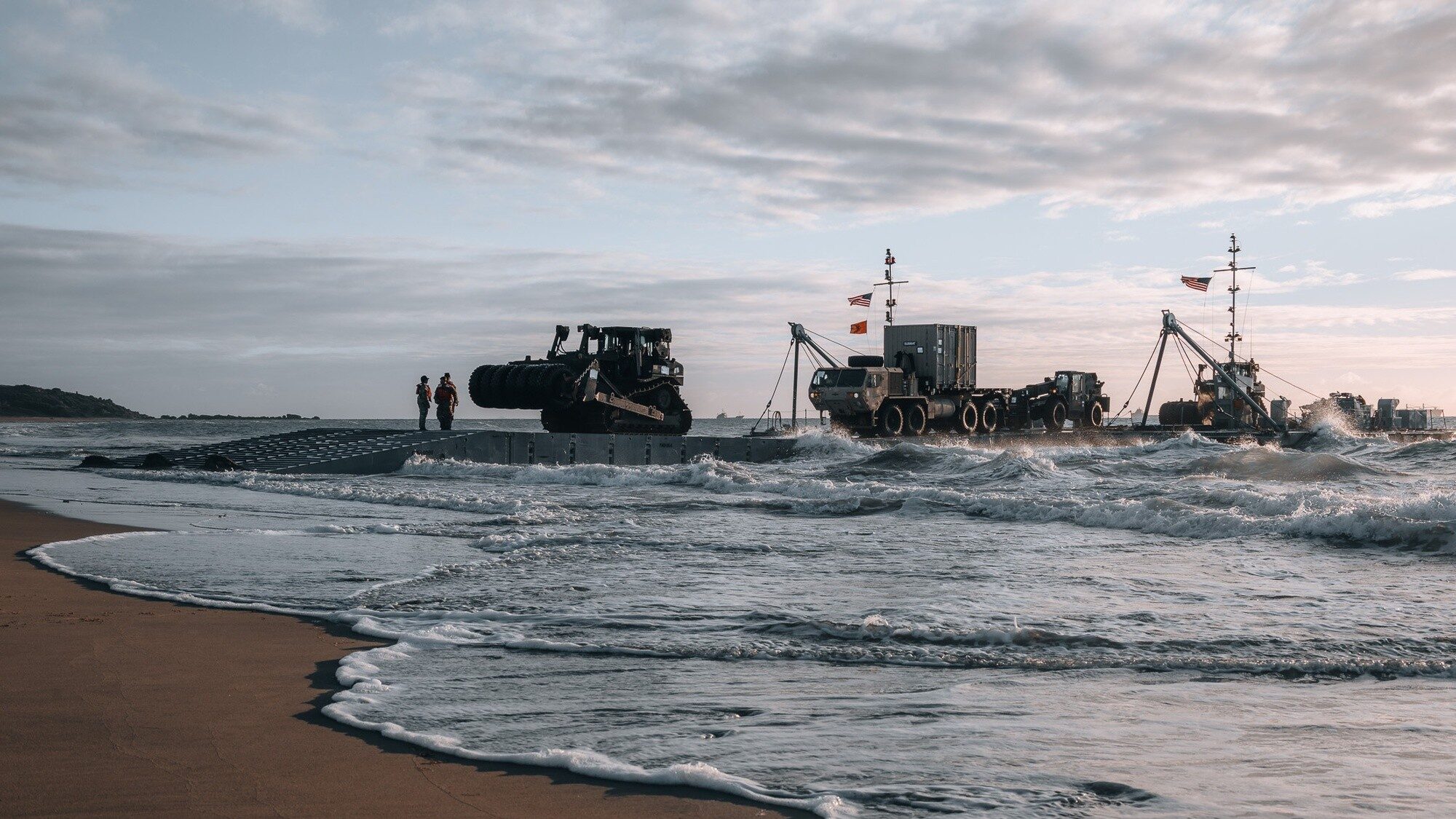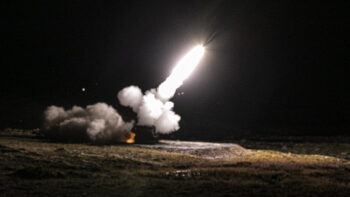
Army mariners discharge vehicles on the beach via the causeway ferry as part of the joint logistics over-the-shore operation during Talisman Sabre 2023 in Bowen, Australia on July 31, 2023. (US Army/Maj. Jonathon Daniell)
WASHINGTON — Exercise Talisman Sabre 23 is a wrap, and the US Army is now armed with new knowledge about Pacific logistics to drive material investments and help refine its operating concept, including a decision to leave more equipment in Australia, according to a two-star general overseeing the event.
That biennial exercise between the US and Australia is billed as a cornerstone of Operation Pathways, and the US Army leaned on more than 2,000 military logisticians to test out some of its contested logistics assumptions and concepts not typically practiced, 8th Theater Sustainment Command Maj. Gen. Jered Helwig told Breaking Defense on Thursday.
“Every plan you do does not survive the first day,” Helwig said, echoing the famous maxim by a Prussian general (or heavyweight boxer Mike Tyson). “We had to make some quick changes, and having the combined joint theater sustainment component, which was a mix of us and Australian partners, really helped us get after those things.”
This year’s event required the service to pull five unit sets worth of equipment from its Army Prepositioned Stock (APS) 3, also known as an APS afloat. That stockpile consists of seven ships continuously sailing around, filled with equipment for European, Indo-Pacific and Middle Eastern theaters. Five unit sets is about one-third of one ship’s stock.
Australia’s strict agricultural inspection guidelines, including searching inbound military weapons for pests, meant the service spent months deep cleaning the weapons and vehicles in Hawaii before loading back onto a ship with an agricultural inspector onboard outfitted with pesticides.
“We did a really good job of cleaning… but they did find a few [insects],” Helwig said. “But, because of the relationship that we built with the Department of Agricultural, Fisheries and Forestry … they allowed us to mitigate that in a way” that only took days and not weeks. Once cleared to bring that equipment ashore, the service constructed a causeway ferry to drive the vehicles ashore.
“We had a [Palletized Load System truck], we had to pull out with a [bull]dozer, but that’s normal. And, we’re still working to get a tank off… the super ferry but that’ll in the next couple days sort itself out,” Helwig added.
That learning process helped drive a decision, and subsequent agreement, for the US Army to keep some of that “logistic support equipment,” like tanker trucks and other transportation equipment, inside Australia instead of loading it back onto the APS 3 ships, Helwig said.
“For the next exercise, we won’t have to put that through the agricultural inspections, it’ll just be here for us and it’ll help us set conditions much faster,” he added.
Next time around, Helwig said his team is interested in testing out advanced manufacturing capabilities like 3-D printing, something they did not do this year. However, the Army was able to tap into Australia’s defense industrial base to source spare parts. For example, when one M1 Abrams tank was damaged during transport on a civilian truck, the Army was able to buy parts in the country.
“It’s a first for us, [but] the US Marines have done a little bit of it,” he added. “But, as we’ve come in at this scale, it’s helped us really see where we can benefit from the relationship that we have with Australia.”
Read Out
With the exercise done and dusted, Helwig and his team are now tasked with penning after action reports for leaders within the US Indo-Pacific Command, Army Training and Doctrine Command, and the Army Futures Command (AFC). Those reports, the two-star general said, will include details about the exercise, along with his recommendations for tweaking logistics operations and weapons requirements.
On that latter acquisition piece, the AFC is standing up a new “contested logistics” cross functional team tasked with focusing on investment plans for a long-distance fight. While specifics about that new CFT have not been completely unfurled, it expected to oversee the requirements and development of things like the new Maneuver Support Vessel-Light and a -Heavy to transport people and equipment over waters in the region.
While work on the MSV-L is currently underway, the Army is sorting through plans for that heavier watercraft and Helwig said his team will provide feedback from events in Australia to potentially help the service craft MSV-H plans.
Helwig’s command also gleaned several recommendations based off a joint petroleum over-the-shore exercise during Talisman Sabre 23 that involved soldiers laying three miles of pipe to move fuel from the waterline up to an airfield inland. Based on that experience, Helwig said will ask the AFC to look at repackaging heavy piping and big pumps that often require a forklift to move.
“The piping itself went in, in like 48 hours. It wasn’t that difficult,” he explained. “But the number of containers and the requirement to transit, that all takes a lot of additional infrastructure and equipment. Could we do it smaller and in the future?”






















